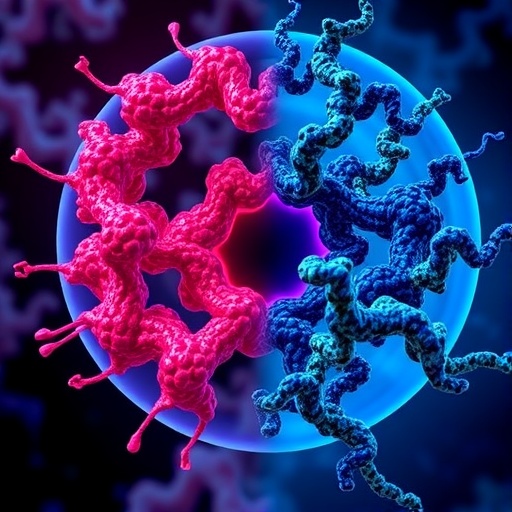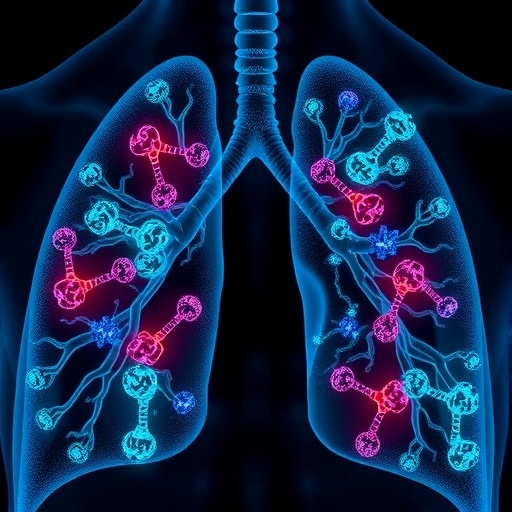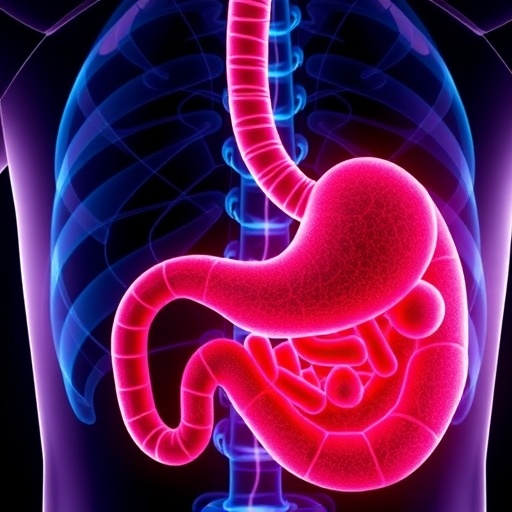In recent years, the molecular intricacies of protocadherins, a family of cell-adhesion molecules predominantly expressed in the nervous system, have captivated researchers. Among these, Protocadherin 9 (PCDH9) emerges as a particularly enigmatic protagonist, exhibiting a paradoxical role that spans oncological, neurological, and developmental domains. A groundbreaking study recently published in Medical Oncology elucidates this dual-faced nature of PCDH9, underscoring its complex regulatory functions within tumorigenesis alongside its critical involvement in neurological and developmental disorders. This revelation not only bridges disparate fields of biomedical science but also sparks a re-evaluation of therapeutic strategies targeting adhesion molecules.
Protocadherins are quintessential players in the formation and maintenance of precise neural circuits, orchestrating cell-cell communication and ensuring the fidelity of neurodevelopmental processes. PCDH9, a subtype within this family, distinguishes itself by its expression pattern and regulatory capacities. Historically, protocadherins were celebrated for their purely structural roles; however, recent evidence, including this study by Li, Wang, Tong, and colleagues, positions PCDH9 at the crossroads of cellular adhesion and intracellular signaling pathways—both of which decisively influence cellular behavior in health and disease.
The study meticulously unpacks the dualistic function of PCDH9 in tumor biology. On one hand, PCDH9 acts as a tumor suppressor, with evidence highlighting its ability to inhibit proliferation and induce apoptosis in various cancer cell types. This suppressive effect is mediated through intricate signaling cascades involving key pathways such as Wnt/β-catenin, which governs cell cycle regulation and epithelial-to-mesenchymal transition (EMT). By downregulating oncogenic signals, PCDH9 imposes a tightly regulated check on unchecked cellular growth, forestalling metastatic progression.
Conversely, the paradoxical oncogenic potential of PCDH9 surfaces in specific tumor contexts, where its aberrant overexpression or mutation fosters malignancy progression and chemoresistance. This contrast is a telling reminder of the role context plays in molecular oncology. For instance, in gliomas, elevated PCDH9 correlates with increased malignancy grade and poor prognostic outcomes, suggesting that PCDH9’s role is nuanced, possibly influenced by tumor microenvironment cues or epigenetic modifications. Thus, PCDH9 transitions from a guardian to an accomplice in tumorigenesis depending on cellular milieu and genetic landscape.
Turning to the nervous system, PCDH9’s involvement in neurodevelopment is no less multifaceted. Neural development demands exquisitely timed cellular adhesion and signaling events to establish neural networks. This study presents compelling data associating PCDH9 dysfunction with a spectrum of developmental disorders marked by cognitive impairment, motor dysfunction, and neuropsychiatric symptoms. The authors delineate mechanistic frameworks where PCDH9 influences synaptic formation, dendritic arborization, and neuronal migration—processes indispensable for normal brain architecture and function.
At the molecular level, the interaction between PCDH9 and intracellular partners modulates calcium-dependent adhesion dynamics, affecting signal transduction cascades like Notch and BMP pathways. Disruptions in these pathways due to altered PCDH9 expression or structure yield abnormal neurogenesis and circuit wiring. Moreover, animal models deficient in PCDH9 exhibit phenotypes reminiscent of human neurodevelopmental disorders, providing invaluable in vivo validation of these molecular insights.
The dual role extends further as PCDH9 is implicated in neurological diseases beyond development, including neurodegeneration and psychiatric conditions. The study discusses evidence connecting PCDH9 to the pathophysiology of disorders such as schizophrenia and Alzheimer’s disease, proposing that dysregulated adhesion and synaptic integrity driven by PCDH9 anomalies may underlie neuronal vulnerability. This widens the therapeutic horizon, suggesting that modulating PCDH9 function could ameliorate symptoms or slow disease progression in these intractable conditions.
A fascinating aspect highlighted in the research is the epigenetic regulation of PCDH9. Methylation patterns within the PCDH9 gene promoter emerge as key determinants of its expression in both tumors and nervous tissue. Aberrant methylation silences PCDH9 in various cancers, lifting the repression of oncogenes, while in neurological contexts, dysregulated methylation corresponds with altered neuronal differentiation trajectories. Thus, the epigenome shapes the dual role of PCDH9, offering potential epigenetic biomarkers or therapeutic targets.
The research team also explored the cellular mechanisms underlying PCDH9 trafficking and surface expression. Proper localization of PCDH9 to cell membranes is vital for its function, and disruptions in vesicular transport or post-translational modifications alter its adhesion capabilities. These findings illuminate potential vulnerabilities; pharmacological agents that restore PCDH9 surface expression or mimic its extracellular domain could recalibrate adhesion signaling and curb oncogenic or neurodevelopmental pathology.
Importantly, the study integrates bioinformatics analyses with experimental validations, leveraging transcriptomic datasets across multiple human tissues and tumors. This systems biology approach paints a nuanced landscape of PCDH9 expression profiles, revealing tissue-specific regulatory nodes and co-expressed gene networks. Such integrative methods pave the way for personalized medicine, where PCDH9’s role can be contextualized to individual patient states for optimized interventions.
The clinical implications are profound. By clarifying PCDH9’s dualistic nature, the authors caution against simplistic therapeutic targeting. In cancer, strategies to upregulate PCDH9 may be beneficial in certain contexts but detrimental in others. Similarly, neurological therapies might require fine-tuning of PCDH9 activity rather than outright inhibition or activation. This calls for sophisticated modulators—biologics or small molecules—that achieve precise modulation without triggering off-target effects.
Furthermore, the study opens avenues for diagnostic innovation. PCDH9 expression or methylation status could serve as biomarkers for tumor classification, prognosis, or neurological disease progression. Liquid biopsy approaches detecting circulating extracellular vesicles containing PCDH9 or its fragments hold promise for non-invasive monitoring, spearheading a new age of molecular diagnostics.
As research progresses, understanding how PCDH9 interacts with other protocadherins and adhesion molecules remains critical. The network of protocadherin interactions likely dictates the emergent properties of neural circuits and tumor microenvironments. Dissecting these interactions biochemically and structurally will refine our grasp of cellular adhesion paradigms and yield targets with combinatorial therapeutic potential.
In summary, the revelation of PCDH9’s dual role challenges traditional paradigms that often segregate molecules as either oncogenes or tumor suppressors, or as solely developmental factors. This study advocates a more integrative perspective, recognizing the dynamism and context dependency inherent in molecular biology. Such insights inspire a future where therapeutic design transcends binary classifications, embracing molecular versatility for tailored and effective medical interventions.
This transformative understanding of PCDH9 portends a ripple effect throughout oncology and neurology, galvanizing researchers and clinicians alike to reassess the complexities of adhesion molecules. The convergence of molecular pathways governing tumor progression and neurodevelopment accentuates the interconnectedness of pathologies once considered disparate. Following this line of investigation promises to unravel the shared molecular underpinnings of human disease, ushering in a new era of interdisciplinary biomedical advances.
Subject of Research: Dualistic functions of Protocadherin 9 (PCDH9) in tumor biology, neurological disorders, and developmental diseases.
Article Title: The dual role of PCDH9 in tumors, neurological and developmental diseases.
Article References:
Li, H., Wang, Y., Tong, X. et al. The dual role of PCDH9 in tumors, neurological and developmental diseases. Med Oncol 42, 489 (2025). https://doi.org/10.1007/s12032-025-03056-x
Image Credits: AI Generated
Tags: biomedical research on protocadhercell adhesion molecules in cancercell-cell communication in the nervous systemmolecular intricacies of protocadherinsoncological implications of PCDH9PCDH9 and neurodevelopmental processesPCDH9 dual role in tumorsPCDH9 expression patterns in healthPCDH9’s impact on cellular signaling pathwaysprotocadherins in neurological disorderstherapeutic strategies targeting adhesion moleculestumor suppressor mechanisms of PCDH9





